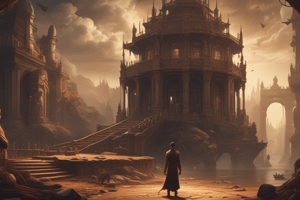Podcast
Questions and Answers
What best describes the effect of a plot in a narrative?
What best describes the effect of a plot in a narrative?
- A collection of random character interactions.
- A series of events linked by cause-and-effect. (correct)
- A straightforward sequence of unrelated events.
- A parallel storyline without main focus.
Which structure is commonly utilized in dramatic works?
Which structure is commonly utilized in dramatic works?
- A single continuous event without divisions.
- Acts, scenes, and plot points. (correct)
- A random distribution of narrators.
- A linear chronological order.
What is Freytag’s pyramid primarily associated with?
What is Freytag’s pyramid primarily associated with?
- Evaluation of poetic forms.
- Analysis of five-act dramatic structure. (correct)
- Examination of themes in literature.
- A study of character development.
Which statement accurately represents a characteristic of dramatic structure?
Which statement accurately represents a characteristic of dramatic structure?
What is meant by a subplot in the context of dramatic structure?
What is meant by a subplot in the context of dramatic structure?
What part of the plot introduces the setting and characters?
What part of the plot introduces the setting and characters?
What is the primary consequence of an information dump in narrative writing?
What is the primary consequence of an information dump in narrative writing?
Which of the following is a technique used for indirect exposition?
Which of the following is a technique used for indirect exposition?
What is NOT a function of the exposition in a story?
What is NOT a function of the exposition in a story?
Which method is least effective for conveying exposition?
Which method is least effective for conveying exposition?
What is the effect of revealing too much information at once through exposition?
What is the effect of revealing too much information at once through exposition?
What phase of Freytag's pyramid follows the exposition?
What phase of Freytag's pyramid follows the exposition?
Which of these is a characteristic feature of effective exposition?
Which of these is a characteristic feature of effective exposition?
What defines a deus ex machina in a narrative?
What defines a deus ex machina in a narrative?
What is a primary characteristic of an anticlimax?
What is a primary characteristic of an anticlimax?
What role does the protagonist's conflict with the antagonist play during the Return or Falling Action?
What role does the protagonist's conflict with the antagonist play during the Return or Falling Action?
What is required during the Return stage of a narrative according to Freytag's rules?
What is required during the Return stage of a narrative according to Freytag's rules?
What is the purpose of the inciting incident in a story?
What is the purpose of the inciting incident in a story?
What is a characteristic of negative climax in a narrative?
What is a characteristic of negative climax in a narrative?
How does modern drama utilize the fall in a story structure?
How does modern drama utilize the fall in a story structure?
How does the rising action contribute to a story?
How does the rising action contribute to a story?
What is typically true about the catastrophe in a narrative?
What is typically true about the catastrophe in a narrative?
What key event typically occurs at the climax of a story?
What key event typically occurs at the climax of a story?
What does the resolution of a story accomplish?
What does the resolution of a story accomplish?
What characterizes an anti-climax in a plot?
What characterizes an anti-climax in a plot?
What changes for the protagonist during the climax of a comedic story?
What changes for the protagonist during the climax of a comedic story?
Why is the rising action considered crucial in a story?
Why is the rising action considered crucial in a story?
What typically happens to the protagonist's fate during the climax?
What typically happens to the protagonist's fate during the climax?
What is a common feature of both the inciting incident and the climax?
What is a common feature of both the inciting incident and the climax?
What is required for a change of fortune to be considered probable in a complex catastrophe?
What is required for a change of fortune to be considered probable in a complex catastrophe?
What emotional effect should a complex catastrophe have on the characters?
What emotional effect should a complex catastrophe have on the characters?
According to Freytag, what is the center of a play's structure?
According to Freytag, what is the center of a play's structure?
Which part of Freytag's dramatic arc represents the resolution of the story’s tension?
Which part of Freytag's dramatic arc represents the resolution of the story’s tension?
What does Freytag identify as necessary for a coherent plot development?
What does Freytag identify as necessary for a coherent plot development?
What occurs after the catastrophe in a narrative, according to the described structure?
What occurs after the catastrophe in a narrative, according to the described structure?
What is described as optional in Freytag's model of plot structure?
What is described as optional in Freytag's model of plot structure?
In the plot diagram example of The Lion King, what does the exposition introduce?
In the plot diagram example of The Lion King, what does the exposition introduce?
Flashcards
Plot
Plot
The sequence of events in a story, where each event causes the next, creating a chain of cause and effect.
Dramatic structure
Dramatic structure
The framework that organizes the plot of a story, helping it unfold in a structured way.
Dramatic structure elements
Dramatic structure elements
A way to break down a story into smaller parts, like acts or scenes. These parts are often connected by key plot points.
Three-act structure
Three-act structure
Signup and view all the flashcards
Freytag's pyramid
Freytag's pyramid
Signup and view all the flashcards
Inciting Incident
Inciting Incident
Signup and view all the flashcards
Rising Action
Rising Action
Signup and view all the flashcards
Climax
Climax
Signup and view all the flashcards
Climax in a Comedy
Climax in a Comedy
Signup and view all the flashcards
Anti-Climax
Anti-Climax
Signup and view all the flashcards
Exposition
Exposition
Signup and view all the flashcards
Falling Action
Falling Action
Signup and view all the flashcards
Resolution
Resolution
Signup and view all the flashcards
Indirect Exposition
Indirect Exposition
Signup and view all the flashcards
Information Dump
Information Dump
Signup and view all the flashcards
Worldbuilding
Worldbuilding
Signup and view all the flashcards
Catastrophe Resolution
Catastrophe Resolution
Signup and view all the flashcards
Exciting Force
Exciting Force
Signup and view all the flashcards
Tragic Force
Tragic Force
Signup and view all the flashcards
Catharsis
Catharsis
Signup and view all the flashcards
Deus ex Machina
Deus ex Machina
Signup and view all the flashcards
Negative Climax
Negative Climax
Signup and view all the flashcards
Catastrophe
Catastrophe
Signup and view all the flashcards
Study Notes
Dramatic Structure of the Plot
- A plot is a sequence of events, each affecting the next, following the principle of cause and effect.
- Plots range from simple to complex, with interconnected subplots and plot points.
- The plot's causal effect can be viewed as a series of events.
Dramatic Structure of a Plot
- The structure of a dramatic work (like a book, play or film) forms a framework for unfolding the story's plot.
- Different dramatic structures exist globally, informed by the acts' structure, and the story's central presentation point.
- Plot structures are often categorized in terms of acts (e.g., three-act or five-act structures).
Freytag's Pyramid
- Freytag's pyramid, a plot diagram created by German playwright Gustav Freytag, outlines the five-act structure commonly used in plots.
- The diagram shows plot components such as exposition (introduction), rising action, climax, resolution/falling action and catastrophe/denouement.
Five Key Elements of Plot Dramatic Structure
- Exposition (Introduction): The opening section of a story; introducing the setting, characters, background information.
- Rising Action: A series of events immediately following the introduction, leading to the climax. The rising action builds tension in one or more stages towards the point of greatest interest.
- Climax: The turning point of the story; a main character confronts their main conflict, often shifting fate. It can also include a moment of significant realization, a revelation, or greatest tension.
- Return/Falling Actions: The aftermath of the climax; the results and consequences of the climax unfold. This can involve suspense about the final outcome, with the protagonist’s fate sometimes out of their control.
- Catastrophe/Resolution/Denouement: The end of the story; resolution(closure), revealing the final outcome in either a simple or complex way.
Anti-Climax/Negative Climax
- Anti-climax occurs when an event expected to be difficult is resolved trivially. The action/tension diminishes unexpectedly.
- Negative climax occurs when the protagonist faces or experiences a loss or major setback that forces them to confront their greatest fears, often with courage to overcome subsequent obstacles.
Return/Falling Action
- Falling action follows the climax, resolving conflicts and tying up loose ends.
- The hostility of the counter-part (villain or antagonist) impacts the protagonist, often unraveling conflicts.
- The number of characters and scenes in this stage are often limited compared to the rising action.
Catastrophe/Resolution/Denouement
- A catastrophe effectively concludes the plot (either simply or through complexity) which resolves or ties up loose ends.
- Foreshadowing is important for a catastrophic conclusion
- The catastrophe may involve character changes, revealing discoveries or fortunes.
- In complex catastrophes, the character's sentiments may shift.
Moment of Catharsis
- Catharsis is a moment after the catastrophe where the action of the story is resolved, releasing tension for the audience, who then process the outcome or final moral message of the story.
Plot Diagram Example - The Lion King
- Exposition: The setting is Pride Rock, and characters are introduced (Mufasa, Sarabi, Simba, Scar, hyenas).
- Inciting Force: Scar kills Mufasa and sends Simba away.
- Rising Action: Simba meets Timon and Pumbaa; Scar takes over the Pride Land and causes hardship. Nala finds Simba, and Rafiki helps him understand his destiny.
- Climax: Simba kills Scar in battle.
- Falling Action: Simba reunites with his mother and Nala.
- Resolution/Denouement: Simba takes his place as king and continues the family line.
### 5 Act Plot Structure Examples
-
The examples provided include Macbeth, Harry Potter and the Sorcerer's Stone, Sicario, The Godfather, Succession, and The Girl with the Dragon Tattoo.
-
Freytag's theory uses emotions in the story as a central point, highlighting contrast to amplify emotional response.
-
Freytag’s model for plot includes an exciting force, which leads to the rise; a tragic force, which leads to the fall, and a final moment of tension, which leads to the final catastrophe.
Studying That Suits You
Use AI to generate personalized quizzes and flashcards to suit your learning preferences.
Related Documents
Description
Test your knowledge on the elements of dramatic structure and exposition. This quiz covers key concepts like Freytag's pyramid, the roles of plot, and techniques used for effective storytelling. Perfect for students of literature and drama!




